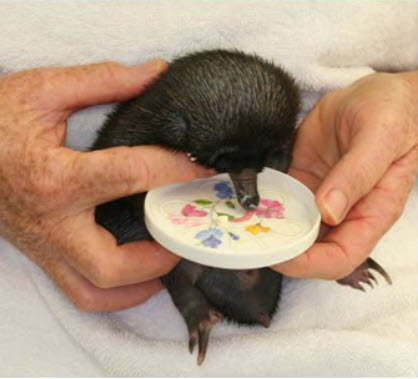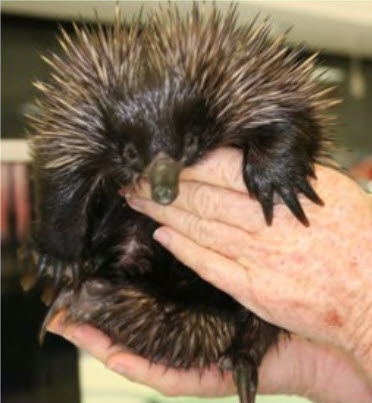Picking up a puggle (Echidna young) always fills me with mixed emotions, sadness for the loss of a mother and excitement for the opportunity to rear such a unique animal. The mother had been hit by a car and the puggle was still in the pouch at the vet clinic. I picked up the puggle at 7.30am on 17 October and, after a quick look to make sure no immediate attention was required, I put it into a six pack esky lined with a cushioning towel. An ice pack, also wrapped in toweling was placed at one end to keep the esky temperature below 28C, and I headed off to Uni. I am always careful to declare live animals when entering any facilities (for health and safety regulations as well as the animals safety) informing the staff that the animal needed to be maintained at constant low temperature and if it was not permitted within the facility the procedures for the day would have to be cancelled. Being a highly specialised facility I was surprised to get the OK, having prepared for the day for some months it would have been inconvenient to say the least to have gone home but I would have done so. The puggle (named P4) remained undisturbed in the esky till 8pm that night when I assessed its age at 20-25 days. Just skin, eyes were dark dots under layers of skin with no eye lids forming yet and no sign of ears.

One of the mother‟s spines had pierced through the abdomen below the pouch but above the cloaca. There was no blood but a dark ring around the neat hole which appeared to be dirt, there was no way of knowing how far the spine had entered the body but gauging the diameter of the hole it appeared to be from a large spine. Other than this injury the puggle was in good condition. After cleaning the wound it was offered droplets of milk on the palm of my hand. Disinterested in the offering it was returned to the esky. There was little to do but wait and hope the spine had missed organs and that no infection developed.
I believe that as close to nature as possible is best and find that it works well for me. I don‟t use any thing other than hot water and mild non fragrant soap to wash surfaces and linen. All my equipment is dried by sunshine whenever possible, eskies are also left to dry outdoors. Echidna milk for a puggle at this stage of life is approximately 13% (bodyweight) and increases to 33% around the time the puggle is well spined. I have an old and trusted recipe that I use in the early stages and slowly wean the puggle on to a mix that contains three parts Wombaroo Puggle milk at the time the spines begin to appear.
After a few days the little puggle was still reluctant to feed so I tube fed it 5mls straight into the stomach. The next day, it readily imbibed 3mls, a drop at a time from the palm of my hand, over the course of one hour. This was not a lot, but a good attempt as it was tired from the effort. The puggle continued to be fed once daily with increasing quantities of milk being consumed.
Although the puggle appeared fine and by day 8 was consuming 8mls a feed I was becoming a little concerned that no movement of urine or faeces had occurred. The puggle took only 3mls on day 10 and doubt began to set in when no formula was taken on day 11. Patience was rewarded when on day 12 it produced both urine and a lovely soft quantity of nice brown faeces. It had managed to smear this all over itself but after a good warm wash it was back into the tucker again. This pattern was repeated a few more times till it settled into regularly producing soft formed crescent shaped pellets.
The spines began to appear at 230g and, at this stage, I began to reduce the feeds to every second day and thereafter decreasing frequency of feeds while increasing quantity and quality of formula.
When it weighed almost 500g the puggle showed no response when given its first small termite mound. However it readily accepted a solid food meatmix recipe. After a few more weeks it began to show interest in termites and keeping up the supply to it and the others in care became my weekly outing.
By late February it was in the outside enclosure waddling in the sunshine and climbing over logs in search of food. The puggle emerged from its burrow usually mid to late morning in the warmth of the day and was fed meatmix twice per week after a reasonable search for food. Termite mounds were replaced regularly but there were also days when no food was supplied. The puggle regularly spent a few hours out of the burrow and was often seen with its four feet splayed out and lying flat on a log baking in the sun.

The only real problem P4 presented was low immunity to ticks. In the hot dry soil the tick burden was a concern with up to 40 immature ticks covering mostly its stomach surface. The decision was made that it would need to be given time to build immunity before release and over the course of a month or so the burden was reduced weekly. Eventually the tick issue subsided and as soon as the termites are active again P4 will be released.
It is essential that all Echidnas, not just puggles, being rescued and in care are kept cool. I keep an ice pack, wrapped in a handtowel, in puggle boxes to keep the temperature down to below 28C till they are old enough to go into the outside enclosure. Puggles below 100g are often not able to regulate their own body temperature.
